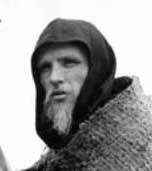


















|
ΑΦΙΕΡΩΜΑΤΑ
ΑΝΤΡΕΙ ΡΟΥΜΠΛΙΩΦ
με αναφορά στον Θεοφάνη τον Έλληνα
Βιογραφικό Σημείωμα
(στην Αγγλική γλώσσα)

LIFE OF ST. ANDREI RUBLEV
(c.1360-70 - c.1427-30)
Feast Day: July 4th
St. Andrei was born near Moscow, and as a youth, knew St. Sergei Radonezhsky (Sergius of Radonezh), who had founded the Monastery of the Holy Trinity about 45 miles from Moscow.
The first mentioning of his name refers to 1405; the document says that for the decoration of the Annunciation Cathedral in Moscow Kremlin there were invited the famous Theophanes the Greek, master Prokhor and monk Andrei Rublev. This means that the painter had already changed the unknown to us name given on birth to the name of Andrei. Historians suppose that Rublev took his vows in the Troitsky monastery (Holy Trinity-St. Sergius Lavra), in the city of Sergiev Posad, under abbot Nikon, pupil and successor of St. Sergei Radonezhsky.
According to the Chronicles, St. Andrei Rublev painted the Moscow Kremlin's Annunciation Cathedral in association with Theophanes the Greek in 1405 and Vladimir's Assumption Cathedral together with Daniel the Black (Daniil Tcherny) in 1408. Those works are the only preserved murals by Andrei Rublev, which show his deviation from the Byzantine school.
To the 1410s art historians refer the 3 frescoes in the Assumption Cathedral in Zvenigorod: Our Savior, Archangel Michael and Apostle Paul. In these icons, especially Our Savior, the new tradition is maturely embodied, marking the beginning of the Golden Age in Russian icon painting. The earliest of St. Andrei Rublev's works are in Zvenigorod (1400).
Probably at that time St. Andrei Rublev painted the Old Testament Trinity, the best of Russian icons. Here he managed to create the mood of spiritual harmony of three souls, the Trinity is an ideal incarnation/embodiment of the complicated theological/divine theme. “The most individual element – and also the most distinctively Russian – is the color scale, which is brighter, more complex, and different in key from that of any Byzantine work. In the hands of a lesser master, such combinations as orange, vermilion, and turquoise might easily have a primitive garishness of the sort we often find in folk art. But here, the controlled intensity of these tones is an essential part of the composition” (History of Art. By H. W. Janson. Fifth Edition. Harry N. Abrams Inc., NY. 1995). Rublev’s Trinity became an example for multiple repetitions and imitations, but none of them reached the same level.
The date of his death, 1430, is the only precise date of his life. He was respected during his life and after his death became a legend, symbol of high spiritual art. However for a long time his authority was based only on the legend, because nobody knew exactly, which works belonged to him for sure, and the most famous of his works, the Trinity, has changed so greatly during time that it's became next to impossible to judge about its merit. Only in the 20th century thanks to works of many researchers and art restorers our understanding and perception of Rublev as one of the geniuses of the world art has been filled with real meaning.
St. Andrei's relics are buried beneath the floor of the Savior Cathedral of the Andronikov Monatery in Moscow, where the blessed one was living and working at the time of his repose, and have yet to be unearthed.
St. Andrei’s Rublev icons were considered to be miraculous. Regrettably, fires and barbarism during the Soviet era have destroyed most of his legacy. Only several icons and fresco details survive to this day.
Our Thanks to Olga’s Gallery
|
|








|


